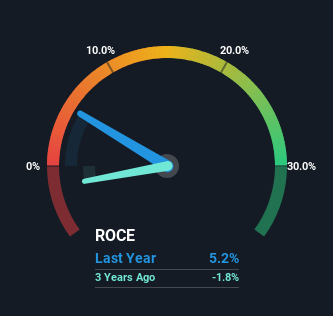- United States
- /
- Professional Services
- /
- NasdaqGM:WLDN
Returns On Capital At Willdan Group (NASDAQ:WLDN) Paint A Concerning Picture
To find a multi-bagger stock, what are the underlying trends we should look for in a business? One common approach is to try and find a company with returns on capital employed (ROCE) that are increasing, in conjunction with a growing amount of capital employed. Put simply, these types of businesses are compounding machines, meaning they are continually reinvesting their earnings at ever-higher rates of return. In light of that, when we looked at Willdan Group (NASDAQ:WLDN) and its ROCE trend, we weren't exactly thrilled.
Understanding Return On Capital Employed (ROCE)
Just to clarify if you're unsure, ROCE is a metric for evaluating how much pre-tax income (in percentage terms) a company earns on the capital invested in its business. To calculate this metric for Willdan Group, this is the formula:
Return on Capital Employed = Earnings Before Interest and Tax (EBIT) ÷ (Total Assets - Current Liabilities)
0.052 = US$10m ÷ (US$395m - US$196m) (Based on the trailing twelve months to June 2023).
Thus, Willdan Group has an ROCE of 5.2%. In absolute terms, that's a low return and it also under-performs the Professional Services industry average of 12%.
View our latest analysis for Willdan Group

In the above chart we have measured Willdan Group's prior ROCE against its prior performance, but the future is arguably more important. If you're interested, you can view the analysts predictions in our free report on analyst forecasts for the company.
So How Is Willdan Group's ROCE Trending?
When we looked at the ROCE trend at Willdan Group, we didn't gain much confidence. Around five years ago the returns on capital were 15%, but since then they've fallen to 5.2%. Although, given both revenue and the amount of assets employed in the business have increased, it could suggest the company is investing in growth, and the extra capital has led to a short-term reduction in ROCE. And if the increased capital generates additional returns, the business, and thus shareholders, will benefit in the long run.
On a side note, Willdan Group's current liabilities have increased over the last five years to 50% of total assets, effectively distorting the ROCE to some degree. If current liabilities hadn't increased as much as they did, the ROCE could actually be even lower. And with current liabilities at these levels, suppliers or short-term creditors are effectively funding a large part of the business, which can introduce some risks.
Our Take On Willdan Group's ROCE
Even though returns on capital have fallen in the short term, we find it promising that revenue and capital employed have both increased for Willdan Group. However, despite the promising trends, the stock has fallen 24% over the last five years, so there might be an opportunity here for astute investors. So we think it'd be worthwhile to look further into this stock given the trends look encouraging.
One more thing: We've identified 3 warning signs with Willdan Group (at least 2 which are potentially serious) , and understanding these would certainly be useful.
While Willdan Group may not currently earn the highest returns, we've compiled a list of companies that currently earn more than 25% return on equity. Check out this free list here.
Valuation is complex, but we're here to simplify it.
Discover if Willdan Group might be undervalued or overvalued with our detailed analysis, featuring fair value estimates, potential risks, dividends, insider trades, and its financial condition.
Access Free AnalysisHave feedback on this article? Concerned about the content? Get in touch with us directly. Alternatively, email editorial-team (at) simplywallst.com.
This article by Simply Wall St is general in nature. We provide commentary based on historical data and analyst forecasts only using an unbiased methodology and our articles are not intended to be financial advice. It does not constitute a recommendation to buy or sell any stock, and does not take account of your objectives, or your financial situation. We aim to bring you long-term focused analysis driven by fundamental data. Note that our analysis may not factor in the latest price-sensitive company announcements or qualitative material. Simply Wall St has no position in any stocks mentioned.
About NasdaqGM:WLDN
Willdan Group
Provides professional, technical, and consulting services primarily in the United States.
Flawless balance sheet with solid track record.
Similar Companies
Market Insights
Community Narratives



